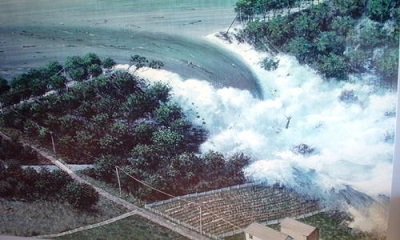Tutorial Library
Learning Point
Dam Failure Disaster
What is Dam Failure Disaster?
A dam is a barrier across flowing water that obstructs, directs or slows down the flow, often creating a reservoir, lake or impoundments. Most dams have a section called a spillway or weir over or through which water flows, either intermittently or continuously, and some have hydroelectric power generation systems installed.
Dams are considered "installations are containing dangerous forces" under International Humanitarian Law due to the massive impact of a possible destruction on the civilian population and the environment. Dam failures are comparatively rare, but can cause immense damage and loss of life when they occur. Dam failures become big Floods.
Cases of Dam Failure Disaster
1979 Machchhu dam failure - The Machchhu dam failure or Morbi disaster was a dam-related flood disaster which occurred on 11 August 1979, in India.
The failure was caused by excessive rain and massive flooding leading to the disintegration of the earthen walls of the four kilometer long Machchu II dam. The spillway capacity provided for 5663 m³/s. The actual observed flow following the intense rainfall reached 16307 m³/s, thrice what the dam was designed for, resulting in its collapse. Within 20 minutes the floods of 12 to 30 ft (3.7 to 9.1 m) height inundated the low-lying areas of Morvi industrial town located 5 km below the dam. During reconstruction of the dam the capacity of the spillway was increased by 4 times and fixed at about 21,000 m³/s.
The Machchu-2 dam, situated on the Machhu River, burst, sending a wall of water through the town of Morbi (now in the Morbi district of Gujarat, India. Estimates of the number of people killed vary greatly ranging from 1800 to 25000 people.
Causes of Dam Failure Disaster
- Overtopping caused by floods that exceed the capacity of the dam.
- Deliberate acts of sabotage.
- Structural failure of materials used in dam construction.
- Movement and/or failure of the foundation supporting the dam.
- Settlement and cracking of concrete or embankment dams.
- Piping and internal erosion of soil in embankment dams.
- Inadequate maintenance and upkeep.

Effects of Dam Failure Disaster
Economic - During floods (especially flash floods), roads, bridges, farms, houses and automobiles are destroyed. People become homeless. Additionally, the government deploys firemen, police and other emergency apparatuses to help the affected. All these come at a heavy cost to people and the government. It usually takes years for affected communities to be re-built and business to come back to normalcy.
Environment - The environment also suffers when floods happen. Chemicals and other hazardous substances end up in the water and eventually contaminate the water bodies that floods end up in. The flooding caused massive leakage in nuclear plants and has since caused high radiation in that area.
People and animals - Many people and animals have died in flash floods. Many more are injured and others made homeless. Water supply and electricity are disrupted and people struggle and suffer as a result. In addition to this, flooding brings a lot of diseases and infections including military fever, pneumonic plague, dermatopathia and dysentery. Sometimes insects and snakes make their ways to the area and cause a lot of havoc.
Safety tips during Dam Failure Disaster
- Flash floods occur in a short spate of time. As soon as they start, be quick, keep safe and ensure that children and elderly are safe by leaving the house to a higher ground.
- Turn off all electrical appliances, gas, heating and the like if there is a bit of time.
- Leave the area before it gets too late. Do not drive through the water as moving water can sweep you away.
- Stay away from power lines or broken power transmission cables.
- Try to keep away from flood water as it may contain chemicals or other hazardous materials.
Very Useful (0)
Useful (0)
Not Useful (0)
Please login to your account by completing this form
Reset Your password
Please enter the email address you signed up with and we'll send you a password reset link.
A reset password link has been generated and will be sent to you via email.
You can then follow that link and select a new password.
Completing that action will allow you to reset your password and then you can insert a new one.
Please enter the email address you signed up with and we'll send you a password reset link.
A reset password link has been generated and will be sent to you via email.
You can then follow that link and select a new password.
Completing that action will allow you to reset your password and then you can insert a new one.